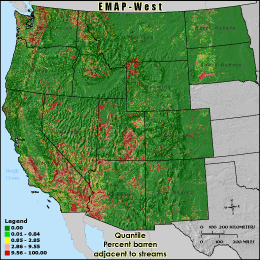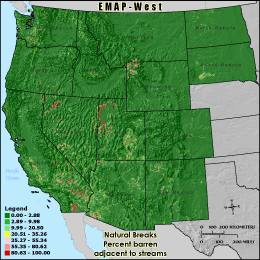|
|
Methodology and Interpretation
RBAR0 - Percent barren adjacent to streams
The percentage of barren land cover adjacent to streams is calculated by
dividing the number of barren land cover cells underneath stream segments in the
3 km grid cell reporting unit and dividing by the stream corridor's total land area
(total number cells underneath stream segments minus those classified as water).
This metric can be used to identify areas bordering streams which may be more
susceptible to increased water run off which may in turn cause soil loss and stream
and lake sedimentation.


Quantile: Each class contains an approximately equal number (count) of features. A quantile
classification is well-suited to linearly distributed data. Because features are grouped by the number
within each class, the resulting map can be misleading, in that similar features can be separated into
adjacent classes, or features with widely different values can be lumped into the same class. This
distortion can be minimized by increasing the number of classes.
Natural Breaks: Classes are based on natural groupings of data values. Natural break points
are identified by looking for groupings and patterns inherent in the data. The features are divided
into classes whose boundaries are set where there are relatively large jumps in the distribution of
data values.
* EMAP-West Landscape Metrics Metadata (FGDC)
|
|

